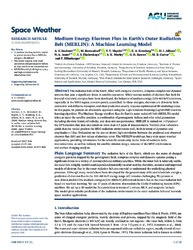Medium Energy Electron Flux in Earth's Outer Radiation Belt (MERLIN): A Machine Learning Model
Smirnov, A. G.; Berrendorf, M.; Shprits, Y. Y.; Kronberg, E. A.; Allison, H. J.; Aseev, N. A.; Zhelavskaya, I. S.; Morley, S. K.; Reeves, G. D.; Carver, M. R.; Effenberger, F., 2020: Medium Energy Electron Flux in Earth's Outer Radiation Belt (MERLIN): A Machine Learning Model. In: Space Weather, Band 18, 11, DOI: 10.23689/fidgeo-3986.
 |
View/
|
The radiation belts of the Earth, filled with energetic electrons, comprise complex and dynamic systems that pose a significant threat to satellite operation. While various models of electron flux both for low and relativistic energies have been developed, the behavior of medium energy (120–600 keV) electrons, especially in the MEO region, remains poorly quantified. At these energies, electrons are driven by both convective and diffusive transport, and their prediction usually requires sophisticated 4D modeling codes. In this paper, we present an alternative approach using the Light Gradient Boosting (LightGBM) machine learning algorithm. The Medium Energy electRon fLux In Earth's outer radiatioN belt (MERLIN) model takes as input the satellite position, a combination of geomagnetic indices and solar wind parameters including the time history of velocity, and does not use persistence. MERLIN is trained on >15 years of the GPS electron flux data and tested on more than 1.5 years of measurements. Tenfold cross validation yields that the model predicts the MEO radiation environment well, both in terms of dynamics and amplitudes o f flux. Evaluation on the test set shows high correlation between the predicted and observed electron flux (0.8) and low values of absolute error. The MERLIN model can have wide space weather applications, providing information for the scientific community in the form of radiation belts reconstructions, as well as industry for satellite mission design, nowcast of the MEO environment, and surface charging analysis. Plain Language Summary:
The radiation belts of the Earth, which are the zones of charged energetic particles trapped by the geomagnetic field, comprise complex and dynamic systems posing a significant threat to a variety of commercial and military satellites. While the inner belt is relatively stable, the outer belt is highly variable and depends substantially on solar activity; therefore, accurate and improved models of electron flux in the outer radiation belt are essential to understand the underlying physical processes. Although many models have been developed for the geostationary orbit and relativistic energies, prediction of electron flux in the 120–600 keV energy range still remains challenging. We present a data‐driven model of the medium energies (120–600 keV) differentialelectron flux in the outer radiation belt based on machine learning. We use 17 years of electron observations by Global Positioning System (GPS) satellites. We set up a 3D model for flux prediction in terms of L‐values, MLT, and magnetic latitude. The model gives reliable predictions of the radiation environment in the outer radiation belt and has wide space weather applications. Key Points:
A machine learning model is created to predict electron flux at MEO for energies 120–600 keV.
The model requires solar wind parameters and geomagnetic indices as input and does not use persistence.
MERLIN model yields high accuracy and high correlation with observations (0.8).
Statistik:
View StatisticsCollection
This is an open access article under the terms of the Creative Commons Attribution License, which permits use, distribution and reproduction in any medium, provided the original work is properly cited.

